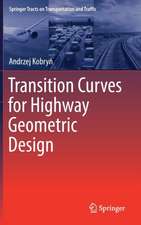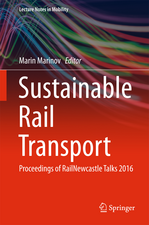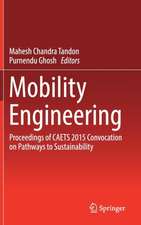Highways
Autor C. A. O'Flahertyen Limba Engleză Paperback – 19 dec 2001
Preț: 310.50 lei
Preț vechi: 579.58 lei
-46% Nou
59.42€ • 61.81$ • 49.06£
Carte tipărită la comandă
Livrare economică 07-21 aprilie
Specificații
ISBN-10: 0750650907
Pagini: 570
Ilustrații: black & white illustrations
Dimensiuni: 174 x 246 x 31 mm
Greutate: 0.98 kg
Ediția:Revizuită
Editura: CRC Press
Colecția CRC Press
Public țintă
Undergraduate and postgraduate students of civil engineering. Junior qualified engineers and techniciansCuprins
Introduction: An historical overview of the development of the road
C. A. O'Flaherty
Chapter 1 Road location
C. A. O'Flaherty
1.1 Complexity of the location process 1.2 Overview of the location process 1.3 Location surveys in non-built-up locales 1.4 Road location in built-up area 1.5 Locating water crossings 1.6 Aerial photography 1.7 Other remote sensing techniques 1.8 References
Chapter 2 Ground investigations
C. A. O'Flaherty
2.1 Investigation aims 2.2 Sequencing of the investigation 2.3 Subsurface exploration methods 2.4 Preparing the main report 2.5 References
Chapter 3 Plans, specifications and contracts
A. Boyle
3.1 Classical steps in preparing a program for a major road; An overview 3.2 Documentation of a major road improvement project 3.3 The European dimension 3.4 References
Chapter 4 Soils for roadworks
C. A. O'Flaherty
4.1 Soil formation and types of soil 4.2 Soil profiles 4.3 Soil particles 4.4 Soil water 4.5 Soil phase relationships 4.6 Frost action in soils 4.7 Identification and description of soils in the field 4.8 Soil classification 4.9 Basic soil tests 4.10 References
Chapter 5 Materials used in road pavements
M. J. Brennan and C. A. O'Flaherty
5.1 Penetration-grade refinery bitumens 5.2 Natural asphalts 5.3 Cutback bitumens 5.4 Bitumen emulsions 5.5 Road tars and tar-bitumens 5.6 Modified bitumens 5.7 Cements 5.8 Limes 5.9 Conventional aggregates 5.10 Secondary aggregates 5.11 References
Chapter 6 Soil-stabilised pavements
C. A. O'Flaherty
6.1 Why stabilise soils? 6.2 Mechanical stabilisation 6.3 Cement stabilisation 6.4 Lime stabilisation 6.5 Construction of cement- and lime-treated courses in pavements 6.6 Bituminous stabilisation 6.7 References
Chapter 7 Surface drainage for roads
C. A. O'Flaherty
7.1 Importance of surface drainage 7.2 Types and uses of surface drains 7.3 Estimating the surface run-off 7.4 Draining the carriageway 7.5 References
Chapter 8 Sub-surface moisture control for road pavements
C. A. O'Flaherty
8.1 Why sub-surface moisture control is so important 8.2 Protecting the road pavement and foundation 8.3 Designing and laying conventional longitudinal subdrains 8.4 French drains 8.5 Geotextiles in drains 8.6 References
Chapter 9 Introduction to pavement design
C. A. O'Flaherty
9.1 Evolution of the road pavement 9.2 The component layers of a road pavement 9.3 Some basic considerations affecting pavement design 9.4 Flexible pavement design methods 9.5 Rigid pavement design considerations 9.6 References
Chapter 10 Earthworks and unbound bases for pavements
C. A. O'Flaherty
10.1 Establishing the horizontal and vertical alignments 10.2 Earthworks quantities 10.3 Balancing earthworks quantities 10.4 Excavation and earthmoving equipment 10.5 Compaction specifications 10.6 Compaction equipment for earthworks 10.7 Constructing embankments on soft soils 10.8 Materials used in embankments 10.9 Preparing the subgrade 10.10 Unbound capping and subbase layers 10.11 Unbound roadbases 10.12 References
Chapter 11 Premixed bituminous-bound courses: Standard materials
M. J. Brennan and C. A. O'Flaherty
11.1 Advantages and disadvantages of standard material specifications 11.2 Harmonisation of European standards 11.3 Mechanisms by which asphalts and coated macadams distribute traffic stresses 11.4 Standard material specifications currently used in the United Kingdom 11.5 Possible future wearing course standard materials 11.6 References
Chapter 12 Design and construction of hot-mix bituminous
surfacings and roadbases
S. E. Zoorob
12.1 Why design bituminous paving mixtures? 12.2 Standard 'recipe' approach 12.3 Engineering design approach 12.4 Outline of procedure for analysing a compacted paving mixture 12.5 Terms used in bituminous mix design 12.6 Marshall method of mix design 12.7 Advanced mix design methods 12.8 Construction methods fot hot-mix hot-laid bituminous materials 12.9 References
Chapter 13 Concrete pavement construction
C. A. O'Flaherty
13.1 Steps in the construction process 13.2 Preparing the foundation 13.3 Placing the forms for conventional paving trains 13.4 Joint assemblies and reinforcement 13.5 Preparing the concrete 13.6 Placing and finishing the concrete 13.7 Texturing of running surfaces 13.8 Curing the concrete 13.9 Other pavements with concrete 13.10 References
Chapter 14 Current British design practice in relation to
bituminous and concrete pavements
C. A. O'Flaherty
14.1 Introduction 14.2 Foundation design 14.3 Traffic assessment 14.4 Thickness design of flexible and rigid pavements 14.5 References
Chapter 15 Analytical design of flexible pavements
J. McElvaney and M. S. Snaith
15.1 Introduction 15.2 Pavement design period and design loading 15.3 Structural analysis of layered elastic systems 15.4 Design criteria used in analytical methods 15.5 Pavement material and subgrade properties required for structural analysis 15.6 Layer characterisation for purposes of structural analysis 15.7 Damage computatations and performance models 15.8 Concluding comments 15.9 References
Chapter 16
Chapter 17 Basic road maintenance operations
J. E. Oliver
17.1 Importance of maintenance 17.2 Scope of road maintenance 17.3 Maintenance management systems 17.4 Maintenance rating systems for bituminous roads 17.5 Maintenance rating systems for concrete roads 17.6 Maintenance of bituminous roads 17.7 Maintenance of concrete roads 17.8 Maintenance of unsurfaced soil-aggregate roads 17.9 Maintenance of other roadway features 17.10 Winter maintenance operations 17.11 External influences on maintenance operations 17.12 Future directions of road maintenance 17.13 References
Chapter 18
Chapter 19 Design and usage of surface treatments
H. A. Khalid
19.1 Surface treatment types and purposes 19.2 Surface dressings recommended in Road Note 39 19.3 Factors affecting the use of surface dressing systems 19.4 Theory underlying the design of surface dressing 19.5 Applying surface dressing and avoiding failure 19.6 Slurry seals 19.7 Thin surface treatments 19.8 References
Chapter 20 Structural maintenance of roads
D. McMullen and M. S. Snaith
20.1Introduction 20.2 Concept of pavement strengthening 20.3 Structural assessment procedure 20.4 Use of deflection measurements 20.5 Use of deflection-life relationships 20.6 Overlay design methods for flexible pavements 20.7 Overlay design methods for concrete pavements 20.8 References
























